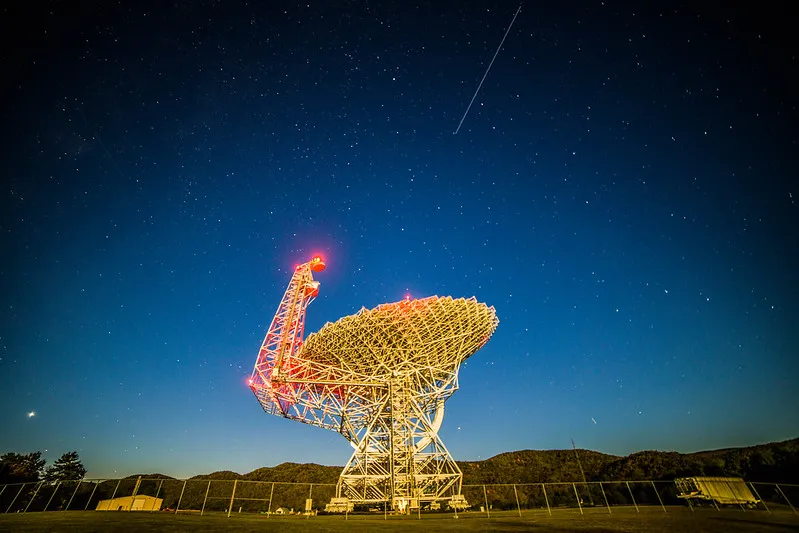Astronomers have used the Atacama Large Millimeter/submillimeter Array (ALMA) together with a suite of space- and ground-based telescopes, to study AT 2024wpp, the most luminous fast blue optical transient (LFBOT) ever observed.
Recent News
Astronomers Make First Radio Detection of Rare Supernova Type, Revealing Secrets of Stellar Death
Astronomers using the U.S. National Science Foundation Very Large Array have captured the first-ever radio signals from a rare class of stellar explosion known as a Type Ibn supernova.
NSF National Radio Astronomy Observatory and Mexican Institutions Sign Historic Agreements to Advance ngVLA Collaboration
The U.S. National Science Foundation National Radio Astronomy Observatory (NSF NRAO), in partnership with several leading Mexican universities and research institutes, has announced a series of landmark agreements and meetings aimed at advancing Mexico’s role in the Next Generation Very Large Array (ngVLA) project.
Massive Stars Born from Violent Cosmic Collapse

Credit: NSF/AUI/NSF GBO/J. Seymour
Astronomers using the U.S. National Science Foundation Green Bank Telescope reveal new process of star formation, challenging existing models
Controlled chaos is a key part of forming massive stars. An international team of astronomers has observed evidence that massive stars can be born from rapidly collapsing clouds of gas and dust, challenging long-held assumptions about star formation. The heavy elements that heavy stars create, like iron or calcium, are scattered across the Universe when they collapse as supernovas. These elements become part of new stars, new planets—and everything in between.
The research team analyzed 44 high-mass starless clumps (HMSCs) using the U.S. National Science Foundation’s Green Bank Telescope (NSF GBT). The scientists discovered that nearly all of these stellar nurseries (43 out of 44) are in a “sub-virial” state, meaning they lack sufficient internal energy to resist gravitational collapse.
This research, led by Prof. Ke Wang of Peking University’s Kavli Institute for Astronomy and Astrophysics, contradicts the prevailing turbulent core model, which assumed these regions were in equilibrium before star formation began. As Wang explains, “Instead, the data we saw suggests a more dynamic process involving rapid collapse. HMSCs are undergoing an almost free-fall collapse, explaining why genuine massive prestellar cores are so rarely observed. To prevent collapse, these regions would require unusually strong magnetic fields. These fields are the invisible scaffolding of the Universe, holding things up in ways astronomers are just beginning to understand.”
This research used the Radio Ammonia Mid-Plane Survey (RAMPS) survey on the NSF GBT. This survey focuses on 24 square degrees of the Galactic Plane, and provides valuable data for understanding the formation of high-mass stars, the structure and composition of molecular clouds, and the dynamics and evolution of our galaxy.
This discovery provides crucial insight into the birth of massive stars, which are responsible for creating the heavy elements essential for life. “The Universe is a giant puzzle, and surprising findings like this are a sweet part of life as an astronomer,” adds Fengwei Xu, co-author of the paper. Existing theoretical models will need to adapt to account for this more violent and rapid star formation process. The team plans to use high-resolution telescopes like the Atacama Large Millimeter/submillimeter Array to further confirm their findings and probe the earliest moments of massive star formation, and future magnetic field measurements within HMSCs.
This research was published in The Astrophysical Journal Letters.
About
The Green Bank Observatory is a major facility of the U.S. National Science Foundation, administered by Associated Universities, Inc., and is a part of the NSF National Radio Astronomy Observatory.
This news article was originally published on the NRAO website on October 22, 2024.
Recent News
ALMA Helps Unmask Monster Black Hole Behind Record-Breaking Cosmic Burst
Astronomers have used the Atacama Large Millimeter/submillimeter Array (ALMA) together with a suite of space- and ground-based telescopes, to study AT 2024wpp, the most luminous fast blue optical transient (LFBOT) ever observed.
Astronomers Make First Radio Detection of Rare Supernova Type, Revealing Secrets of Stellar Death
Astronomers using the U.S. National Science Foundation Very Large Array have captured the first-ever radio signals from a rare class of stellar explosion known as a Type Ibn supernova.
NSF National Radio Astronomy Observatory and Mexican Institutions Sign Historic Agreements to Advance ngVLA Collaboration
The U.S. National Science Foundation National Radio Astronomy Observatory (NSF NRAO), in partnership with several leading Mexican universities and research institutes, has announced a series of landmark agreements and meetings aimed at advancing Mexico’s role in the Next Generation Very Large Array (ngVLA) project.
